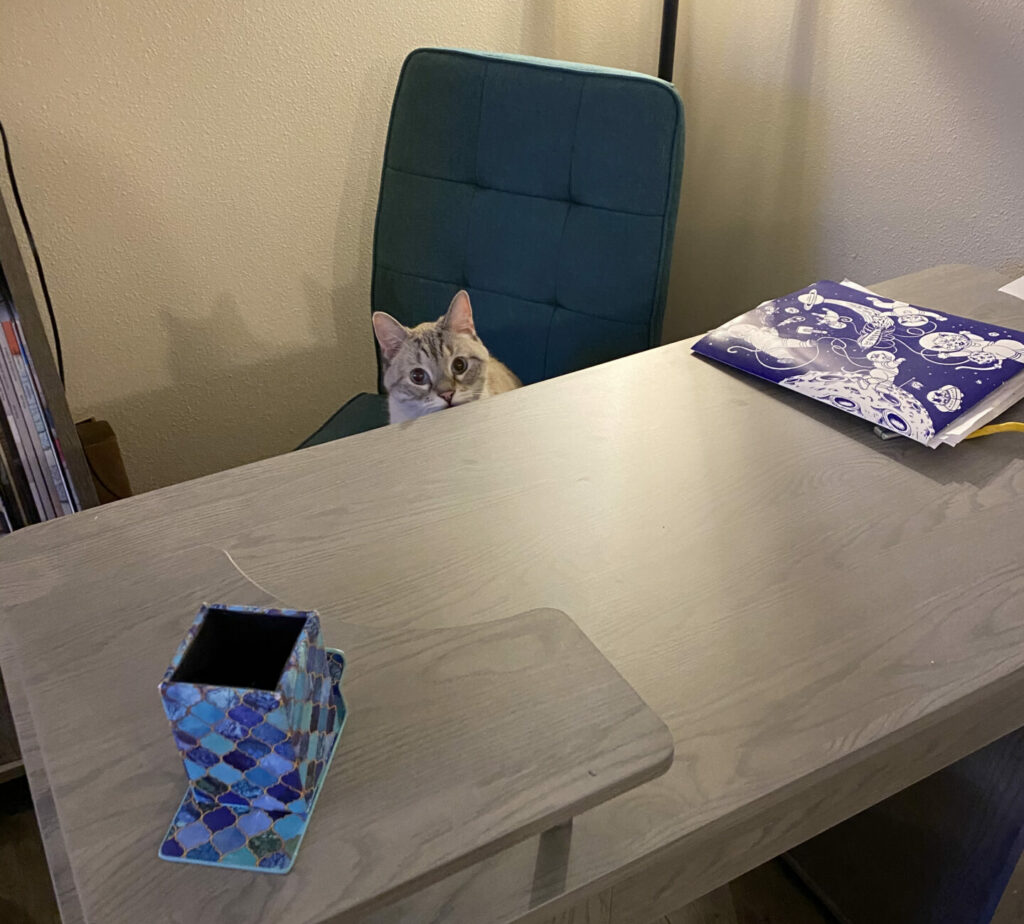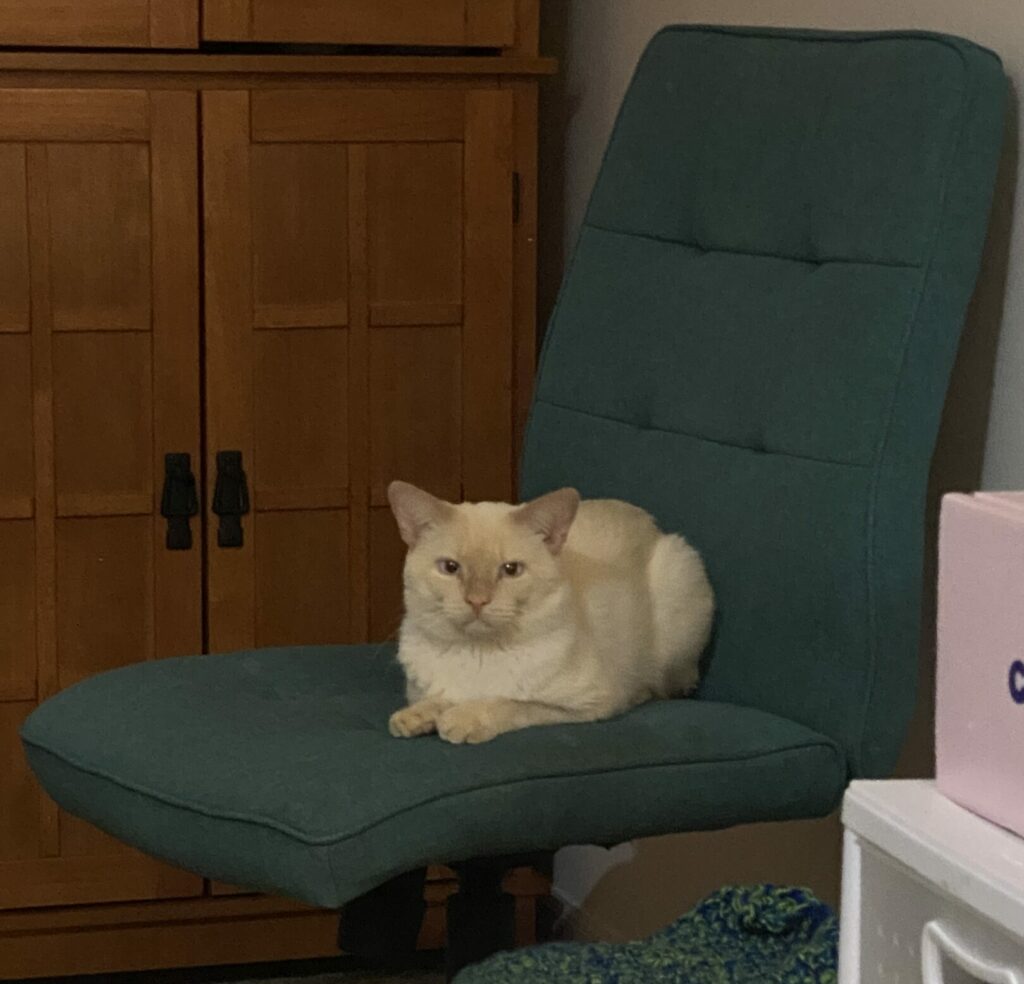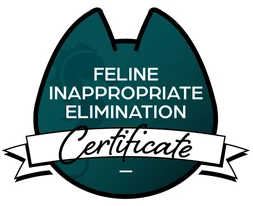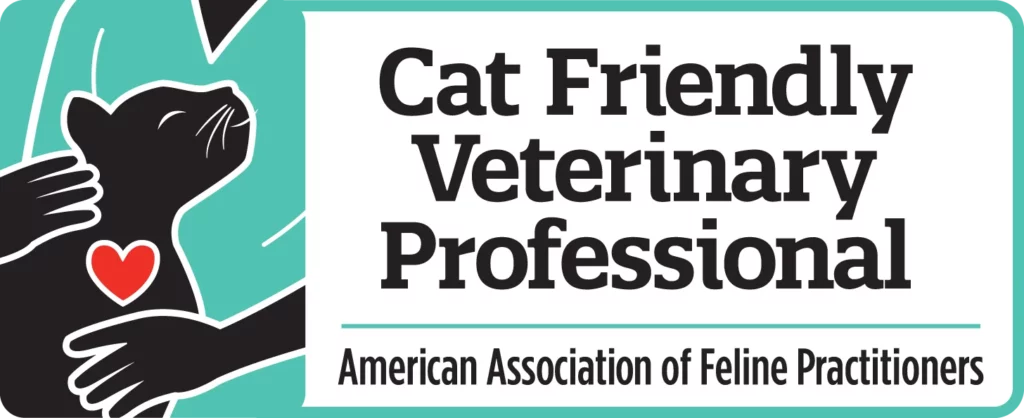I hate to break it to you, but if you have a cat, you need cat furniture. I know, I know. I’m the worst. Hear me out, though! Cat furniture doesn’t need to be ugly. There are some great brands out there like the Refined Feline that make modern cat furniture that looks really nice and meets the needs of your cats.
Of course, most makes of stylish cat furniture know they are making a premium product and charge accordingly. While they tend to be really high-quality products, they may not be in everyone’s budget. This is especially true if you have multiple cats and need more resources for your cats to prevent territoriality!
Thankfully, there are ways you can make, modify, or repurpose other furniture so that your cats’ behavioral needs are met while you still enjoy the look of your home. I have a separate guide on how to DIY a litter box so I won’t go into that here, but we’ll talk about options for other types of cat furniture. Let’s go over a few techniques for DIY cat furniture.
Why Do I Need Cat Furniture?
Before diving into the how portion, I want to briefly touch on why adding furniture for your cats is necessary. I’m not just suggesting people add in cat trees for fun!
Cats have behavioral needs that if not met, they will become stressed and frustrated. Some of the most directly relevant behavior needs include climbing, scratching, and hiding. Stress can be a component of many behavior problems in cats including house soiling and aggressive behaviors. Creating an environment that allows a cat to meet these needs is necessary for a happy, healthy cat. Attempts to suppress these behaviors aren’t going to end well.

Many less severe but still unwanted behaviors can be directly tied to a lack of acceptable outlets for cats’ natural behaviors including destructive scratching and counter surfing. A cat approved scratching post is the best way to deter scratching your furniture, provided you place it in an appropriate location. Similarly, your cat has a natural urge to climb so you aren’t going to see success in keeping them off the counters with a spray bottle. They’re probably up there when you’re not looking!
I have a particular interest in working on situations involving fighting cats. One of the biggest sources of conflict between cats I see is conflict over resources and adding in cat furniture can help prevent or reduce fights. It may not completely resolve the issue in more severe cases, but you won’t see improvement if the cats still feel insecure in their space.
Repurposing Human Furniture
Clearly, if you don’t want cats with behavior concerns or need to hire me for cat behavior help, you’re going to want to add in a few things for your cats. One of the easiest ways to do this is by repurposing something premade for humans into something for your cat. It requires no power tools or carpentry skills and your cat won’t care that it wasn’t marketed toward them. Plus, you have many options that fit the look of your home.
This doesn’t have to be that challenging or even involve purchasing anything. If you have a cubby bookshelf, you can put a blanket or cat bed into one of the cubbies. You can also clear off the top of a bookshelf, an end table, or a nightstand and place somewhere cozy to rest on top of it. That gives your cats a place to perch and relax. If you feel like really treating your cat, you can even get a heated cat bed to help them survive the cold Minnesota winter.
One of my favorite options is finding a stair-shaped bookcase. You can use the natural shape of the bookshelf to allow the cats a way to climb to the top so they have vertical space. The cubbies or shelves can be used for storage, display, or a cozy cat nook. You can even get a cubby insert that creates a cat bed for your cat. If cubbies aren’t your jam, there are plenty of other non-cubby stairway bookshelves that could easily be transformed into a kitty playground out there.
Worried about the cats jumping on the shelf and items on display falling over? Museum putty should secure them so they stay upright.
Whatever you decide to use, it’s important that your cat won’t knock it over when leaping onto or off of the piece of furniture. A while back, there was a lot of talk of children being crushed by falling furniture because it wasn’t secured. Cats could easily fall victim to this as well. Make sure you use any included hardware to secure furniture to a wall. If you lost yours or bought something that didn’t come with something to secure the furniture, you can get wall anchors to make sure it won’t topple.
Listen To What Your Cat Likes
If you’re not sure what kind of furniture to get, chances are your cat may already be giving hints as to what they’d prefer. As an example, let’s talk about The Chair.

The Chair is not just any chair. Back in 2020 when we all began working from home, I was forced to clear off the large pile of clothes I usually kept on The Chair in order to use it as an actual chair. My goofy cat, Zoloft, decided after about a week of me using it that he wanted to sit on it. He would squeeze himself behind me and push me out of The Chair so I had to go sit somewhere else.
Rather than fight it, I ended up buying a new chair for myself. Zoloft would spend much time curled up on The Chair over the following years. Now that he is no longer here, his successors have been known to find themselves lounging on The Chair.

The point of this story? Zoloft clearly liked something about *checks notes* office furniture. He really, really liked office furniture. Rather than fight him on it or try to get him to use something he wasn’t going to be interested in, I just let him have what he wanted and got something else for myself. Whatever it is your cat seems to like, consider getting them one of their very own or getting a fake version (much like the decoy laptop I bought Zoloft) so your cat will still be happy while you can use your furniture uninterrupted.
Find Something That Fits Narrow Spaces
Narrow spaces like hallways or stairs are sometimes challenging places in multicat homes or small living spaces. It can be hard for the cats to navigate around each other in the narrow spaces without feeling trapped and it isn’t easy to put a cat tower in without blocking your ability to navigate the space. Cat shelves are a great option, but for those who rent or with certain layouts, it may not be possible to utilize them.
One way I have people work around hallways is to add thinner pieces of furniture to them to create a second pathway for the cats to move past each other without feeling trapped. Great choices for these include console tables and shoe cabinets as they usually don’t protrude out too much and may be something you’d place in that space anyway. Just make sure you don’t place anything on top of them so the cats have a clear path.
Another particularly challenging and narrow space? Kitchens. While you may not be able to fit something large in the kitchen, you can make use of a large garbage can with a flat lid to give your cat a place to jump up to. You can even train them to sit there rather than being on your counters! Just make sure you get a garbage can with some girth to it. If you don’t, your cat may knock it over when they jump off of it.
Use Built-In Space
Another problem area is the kitchen. Cats getting on counters can be annoying and there are valid concerns about them tracking litter onto the counter. While part of the solution is making sure the counters are cleaned before and after use, providing an appropriate outlet for cats’ natural climbing behavior is going to be even more important.
If you have spaces above your kitchen cabinets that are safe for your cat, you can turn that space into a cat lounge. Adding bedding or a cat tent can create a cozy vibe for your cat. Most people who choose this option use the top of the fridge as a way for the cat to get up. If you go this route, you may want to add a tall cat tower nearby or some shelving to help them get up to the fridge without going on the counter.
Depending on the layout of your home, you may have other built in spaces to work with. Look for anywhere that your cat could climb to and have a chance to overlook their kingdom. As long as there isn’t any way they could be injured being up there and it’s a place that you could easily reach the cat in an emergency, it’s probably something you can transform into a cat haven.
Block Off Under The Bed
A word of caution about a commonly used cat space. While you may intentionally or unintentionally let your cat lounge under your bed, this is actually not a great choice. Why? First, if the best collapses on your cat, the mattress will crush or, at a minimum, severely injure them.
Something that is less commonly considered, though, is what happens if there’s an emergency. Your cat may rush to hide under the bed if they feel safe under the bed. If you can’t easily reach them, you may not be able to pull them out and evacuate quickly. You might also not even realize they’re hiding there. In situations such as house fires where you need to leave immediately, you may not be able to save your cat. That’s a tragedy no one wants.
To block off the bed, you could take a few approaches. If you’re in the market for a new bed frame, a solid one is a great choice. Just make sure your cat can’t sneak in through any openings in it. If you have a raised bed frame, using under-the-bed storage totes has the practical advantage of expanding your storage space while also preventing your cat from getting under the bed. You should pack the space as tightly as you can so there are no gaps that would allow the cat to sneak in on top of the totes or between them.
Make Or Modify Furniture
Of course, you may not find something that fits your needs or style. You may also have a piece of furniture you want to turn into something for your cats, but it doesn’t quite work as is. That’s okay! If you’re handy (or can hire someone who is handy), you can modify or make furniture for your cats. Here are a few methods to try.
Cut Holes In Bookshelves
If you have a bookshelf you want to turn into mixed use cat furniture, you may be worried your cat can’t climb their way up. If you’re handy, you can work around this by cutting holes in the shelves themselves. Just make sure the holes are big enough that your cat can fit through comfortably and sand down any newly exposed edges.
If you want to reserve part of the shelf for display without your cats getting to it, you can always install a piece of wood or put something really bulky on the shelf so your cats can’t get to the other side. A word of caution in multicat households: always make sure the cat can’t become cornered on a shelf. That means that you either need an out on each end that goes up or out the side.
Want to take it up a notch? Consider cutting a small hole in one shelf that fits a food or water bowl. You’ll want to easily remove the bowl for cleaning so don’t seal it in.
Add Scratching Material
If your cat is scratching something nearby, you can turn another piece of furniture into a scratcher. Either cover it with sisal rope or carpet and voila! Cat scratcher. Alternatively, there are premade scratchers that cover table legs or go over furniture.
If you do go this route, make sure to use a material your cat likes to scratch so you don’t end up modifying your furniture in a way your cat won’t use. The scratching surface should also be easy for your cat to find and firmly attached. If it falls off right away or your cat can’t find it, it won’t help to add it to the piece of furniture.
Build Your Own
This one isn’t a practical option for everyone if you don’t have woodworking skills or access to power tools, but for those that do (or know someone who does) you can go full DIY. That means you have complete control over the entire look of the furniture from colors to materials used. You can ensure it meets your visual standards and also meets the needs of your cat.
When starting from scratch to make cat furniture, you always want to make sure the furniture is sturdy, doesn’t have anything your cat could fall on and injure themselves, isn’t made from toxic materials, and meets the cat’s needs.
You’ll also want to be careful with how you make some pieces of furniture so they don’t create a new problem. While it may be tempting to make a litter box enclosure, if you make it too small or it doesn’t have vents for air, the litter box smell will be trapped inside. This may seem like a good thing, but your cat probably won’t appreciate it and may stop using the box. You want a lot of space for your cat to move around inside the enclosure and remember to scoop regularly.
DIY Cat Furniture Is Good For You And Your Cats
While you may not want your home to look like cats live there, the fact of the matter is cats do live there. You need to meet their needs or you’ll end up with bigger, less appealing problems on your hands than an unsightly cat tree. Thankfully, you’re not limited by the choices available at your local pet store. You can easily find furniture meant for humans and turn it into cat furniture. If you have the skills and the tools, making your own cat furniture is an option as well.
If you find all this seems too much to do, remember that there are what I consider semi-DIY options out there. One example of a cat tower that you can modify to fit your needs is the PetLibro Infinity tower. Change up what parts you include or the combination of parts over time to see what appeals to your cat without having to do all the DIY steps.
Remember, it ultimately benefits you to meet your cat’s environmental needs. It saves you a lot of stress and will both happy cats and happy humans.










